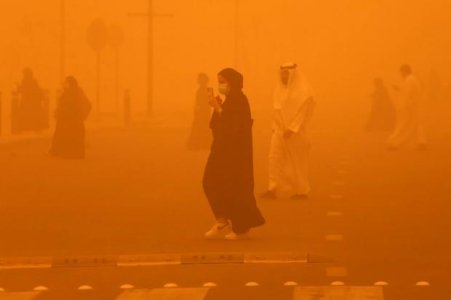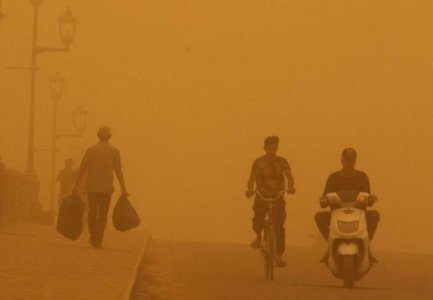silentkiller187
First Class Captain
- Joined
- Nov 9, 2014
- Runs
- 5,483
Iraq closed public buildings and temporarily shut airports Monday as another sandstorm -- the ninth since mid-April -- hit the country.
More than 1,000 people were hospitalised across the nation with respiratory problems, health ministry spokesman Seif al-Badr told AFP.
Flights were also grounded in neighbouring Kuwait for a second time this month, as the region grapples with the increasingly frequent weather phenomenon.
The Iraqi capital Baghdad was enveloped in a giant dust cloud that left usually traffic-choked streets largely deserted and bathed in an eery orange light, AFP correspondents said.
Prime Minister Mustafa al-Kadhemi ordered all work to cease in state-run institutions, except for health and security services, citing "poor climatic conditions and the arrival of violent sandstorms".
Air traffic was suspended at the international airports in Baghdad, Arbil and Najaf, before flights resumed at Baghdad and Arbil.
Iraq is ranked as one of the world's five most vulnerable nations to climate change and desertification.
The environment ministry has warned that over the next two decades Iraq could endure an average of 272 days of sandstorms per year, rising to above 300 by 2050.
Iraq's previous two sandstorms sent nearly 10,000 people to hospital with respiratory problems and killed one person.
More trees needed
The Middle East has always been battered by sandstorms, but they have become more frequent and intense in recent years.
The trend is associated with rising temperatures and water scarcity, the overuse and damming of rivers as well as overgrazing and deforestation.
Oil-rich Iraq is known in Arabic as the land of the two rivers, the Tigris and Euphrates, where the ancient civilisations of Mesopotamia flourished.
Iraq's environment ministry has said the increased sandstorms could be countered with more vegetation cover including trees that act as windbreaks.
A major duststorm last week swept across the region, reaching Saudi Arabia, Kuwait, Iran and the United Arab Emirates.
It left more than 1,200 people hospitalised in Riyadh alone. In Dubai, the world's tallest building was engulfed in a cloud of dust.
Experts predict the phenomenon will worsen as climate change warps regional weather patterns, further dries out and degrades soils and speeds up desertification across much of the Middle East.

<iframe width="800" height="713" src="https://www.youtube.com/embed/9mXgOzMLFPw" title="YouTube video player" frameborder="0" allow="accelerometer; autoplay; clipboard-write; encrypted-media; gyroscope; picture-in-picture" allowfullscreen></iframe>
https://www.france24.com/en/live-ne...torm-grounds-flights-sends-1-000-to-hospitals
More than 1,000 people were hospitalised across the nation with respiratory problems, health ministry spokesman Seif al-Badr told AFP.
Flights were also grounded in neighbouring Kuwait for a second time this month, as the region grapples with the increasingly frequent weather phenomenon.
The Iraqi capital Baghdad was enveloped in a giant dust cloud that left usually traffic-choked streets largely deserted and bathed in an eery orange light, AFP correspondents said.
Prime Minister Mustafa al-Kadhemi ordered all work to cease in state-run institutions, except for health and security services, citing "poor climatic conditions and the arrival of violent sandstorms".
Air traffic was suspended at the international airports in Baghdad, Arbil and Najaf, before flights resumed at Baghdad and Arbil.
Iraq is ranked as one of the world's five most vulnerable nations to climate change and desertification.
The environment ministry has warned that over the next two decades Iraq could endure an average of 272 days of sandstorms per year, rising to above 300 by 2050.
Iraq's previous two sandstorms sent nearly 10,000 people to hospital with respiratory problems and killed one person.
More trees needed
The Middle East has always been battered by sandstorms, but they have become more frequent and intense in recent years.
The trend is associated with rising temperatures and water scarcity, the overuse and damming of rivers as well as overgrazing and deforestation.
Oil-rich Iraq is known in Arabic as the land of the two rivers, the Tigris and Euphrates, where the ancient civilisations of Mesopotamia flourished.
Iraq's environment ministry has said the increased sandstorms could be countered with more vegetation cover including trees that act as windbreaks.
A major duststorm last week swept across the region, reaching Saudi Arabia, Kuwait, Iran and the United Arab Emirates.
It left more than 1,200 people hospitalised in Riyadh alone. In Dubai, the world's tallest building was engulfed in a cloud of dust.
Experts predict the phenomenon will worsen as climate change warps regional weather patterns, further dries out and degrades soils and speeds up desertification across much of the Middle East.

<iframe width="800" height="713" src="https://www.youtube.com/embed/9mXgOzMLFPw" title="YouTube video player" frameborder="0" allow="accelerometer; autoplay; clipboard-write; encrypted-media; gyroscope; picture-in-picture" allowfullscreen></iframe>
https://www.france24.com/en/live-ne...torm-grounds-flights-sends-1-000-to-hospitals
Last edited:






